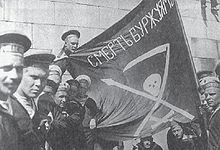Anarchism in Finland
| Part of a series on |
| Anarchism |
|---|
 |
Anarchism in Finland dates back to the early revolutionary movements of the 20th century, seeing organized activity begin in the 1960s.
History
Grand Duchy of Finland

Supporters of anarchism have been in the country since the time of the
The

The peak period of anarchist activity in Finland is considered to be 1906–1909. After the abolition of the first
Independent Finland

Organized anarchist activity did not arise in independent Finland until the 1960s. In the country, however, there were individual Finnish anarchists and anarchist Russian emigrants who were sailors and soldiers that took part in the anarchist
In 1933, a poem by the anarchist
In connection with the
In the 1970s and 1980s, there were anarchist discussion circles and some anarchist small magazines appeared. The first national Finnish anarchist organization can be considered the
Contemporary Finland
Today,
At the turn of the millennium, the
On June 6, 2015, the anarchist alliance
According to the police,
According to the Ministry of the Interior's report on the situation of violent extremism in 2016, the anarchist movement is not very organized, but rather a loose network that communicates via the internet and only gathers from time to time. The most important communication channel is the Takku.net website.[17]
Today, militant antifascists are organized under the name
On October 18, 2014, as the police protected a pre-planned SVL street patrol, another group attacked the patrol. This led to a mass battle of dozens of people.[19] According to a message posted on the Takku site, the opponents were antifascists. The antifascists escaped the police, dropping their iron pipes when the police stopped the fight with pepper spray.[20]
At the end of 2016, the
On October 22, 2017, anti-fascists staged a counter-demonstration in Tampere against a demonstration by the neo-Nazi Nordic Resistance Movement. According to police, among the protesters, torches were thrown at the police and attempts were made to catch the neo-Nazis, who were protected by the police. Police are investigating the actions of protesters in a suspected violent riot.[22]
In 2019, according to the Ministry of the Interior, there were violent far-left groups in some areas in Finland, mostly anarchists and antifascists. The radical movement has been limited and has mainly manifested itself in demonstrations.[23]
References
- ^ Hyvönen, Antti (1963). Suomen vanhan työväenpuolueen historia (in Finnish) (2 ed.). Kansankulttuuri. pp. 162–171.
- ^ Rautiainen, Antti (March 17, 2013). "Anarkismi ennen kriisiä". Uusi Suomi. Archived from the original on December 11, 2013. Retrieved December 7, 2013.
- ^ Leppänen, Liisa; Lempiäinen, Riika. "Järjestyshäiriöitä ja elintarvikepulaa". University of Tampere. Archived from the original on February 8, 2017. Retrieved December 7, 2013.
- ^ Nyström, Samu (2013). Poikkeusajan kaupunkielämäkerta : Helsinki ja helsinkiläiset maailmansodassa 1914–1918 (Thesis). University of Helsinki. pp. 136–137. Archived from the original on November 26, 2020. Retrieved December 29, 2020.
- ^ Vakkilainen, Ari (February 1989). "Venäläiset anarkistit Suomessa 1917–1918". Kapinatyöläinen. Archived from the original on March 4, 2016. Retrieved December 7, 2013.
- ^ "Suomenruotsalainen sotasankari ja anarkisti". Kapinatyöläinen. 1997. Archived from the original on March 4, 2016. Retrieved December 29, 2020.
- ^ Hakulinen, Tuuli (November 25, 2011). "Kronstadtin kapina, osa 1 – pala anarkistista historiaa". Archived from the original on October 14, 2013. Retrieved December 7, 2013.
- ^ Rustanius, Seppo (October 12, 2003). "Kronstadtin pakolaisisten kohtaloista on tekeillä dokumenttielokuva". Etelä-Saimaa (in Finnish). Archived from the original on November 17, 2021. Retrieved December 7, 2013.
- ^ Uskela, Kaarlo (September 24, 2009). "Vainovuosilta". Jurin tekstit. Archived from the original on November 17, 2021. Retrieved March 3, 2015.
- ^ Ekholm, Kai. "Kielletty kotimainen kirjallisuus ja käännöskirjallisuus". Kielletyt kirjat. Sananvapaus ja sensuuri verkkoaikana. Archived from the original on October 29, 2013. Retrieved March 5, 2015.
- ^ Viitanen, Reijo (1994). Punainen aate, sininen vaate. SDNL. p. 492.
- ^ Rautiainen, Antti (2000). "Anarkistit ja järjestäytyminen". Kapinatyöläinen. Archived from the original on May 15, 2007. Retrieved May 2, 2014.
- ^ "Musta Pispala-festivaali 30.9.-2.10". Takku. September 7, 2005. Archived from the original on September 27, 2007. Retrieved December 29, 2020.
- ^ "Anarkistimarttojen kotisivut". Archived from the original on May 4, 2014. Retrieved May 4, 2014.
- ^ Alusta (June 7, 2015). "Anarkistit perustivat liiton" (in Finnish). Avtonom.org. Archived from the original on January 27, 2016. Retrieved January 19, 2016.
- ^ Kuokkanen, Katja (October 2, 2016). "Stadin derbyistä tuli äärioikeiston ja anarkistien taistelutanner – Poliisille tutut lietsojat "näkevät tilaisuuden tapella ja yrittävät olla kasvottomia siellä seassa"" (in Finnish). HELSINGIN SANOMAT. Archived from the original on November 5, 2016. Retrieved December 29, 2020.
- ^ "Väkivaltaisen ekstremismin tilannekatsaus 1/2017". Sisäministeriö. March 1, 2017. Archived from the original on January 18, 2021. Retrieved December 29, 2020.
- ^ "Näin toimii Suomen Vastarintaliike" (in Finnish). Yle artikkelit. May 15, 2016. Archived from the original on February 2, 2021. Retrieved December 29, 2020.
- ^ Kangaspuro, Aino (October 22, 2014). "Uusnatsit tappelivat keskellä Helsinkiä". Iltalehti. Archived from the original on May 15, 2018. Retrieved December 29, 2020.
- ^ "Väkivallan kierre Helsingissä: Nyt antifasistit ja patriootit ottivat yhteen" (in Finnish). MTV uutiset. October 22, 2014. Archived from the original on October 9, 2017. Retrieved December 29, 2020.
- ^ a b c "Supon lista: Nämä 34 asiaa uhkaavat Suomen turvallisuutta – terroristit, äärioikeisto, anarkistit, vakoilu, maakaupat..." (in Finnish). Ilta-Sanomat. November 29, 2016. Archived from the original on March 4, 2017. Retrieved March 4, 2017.
- ^ Manninen, Tuomas (October 21, 2017). "Uusnatsit ja vastamielenosoittajat ottivat yhteen Tampereella – poliisi tutkii väkivaltaista mellakkaa". Ilta-Sanomat. Archived from the original on October 25, 2017. Retrieved October 25, 2017.
- ^ "Väkivaltaiset ääriliikkeet toimivat koko maan alueella". Sisäministeriö. April 16, 2020. Archived from the original on January 15, 2021. Retrieved December 29, 2020.
